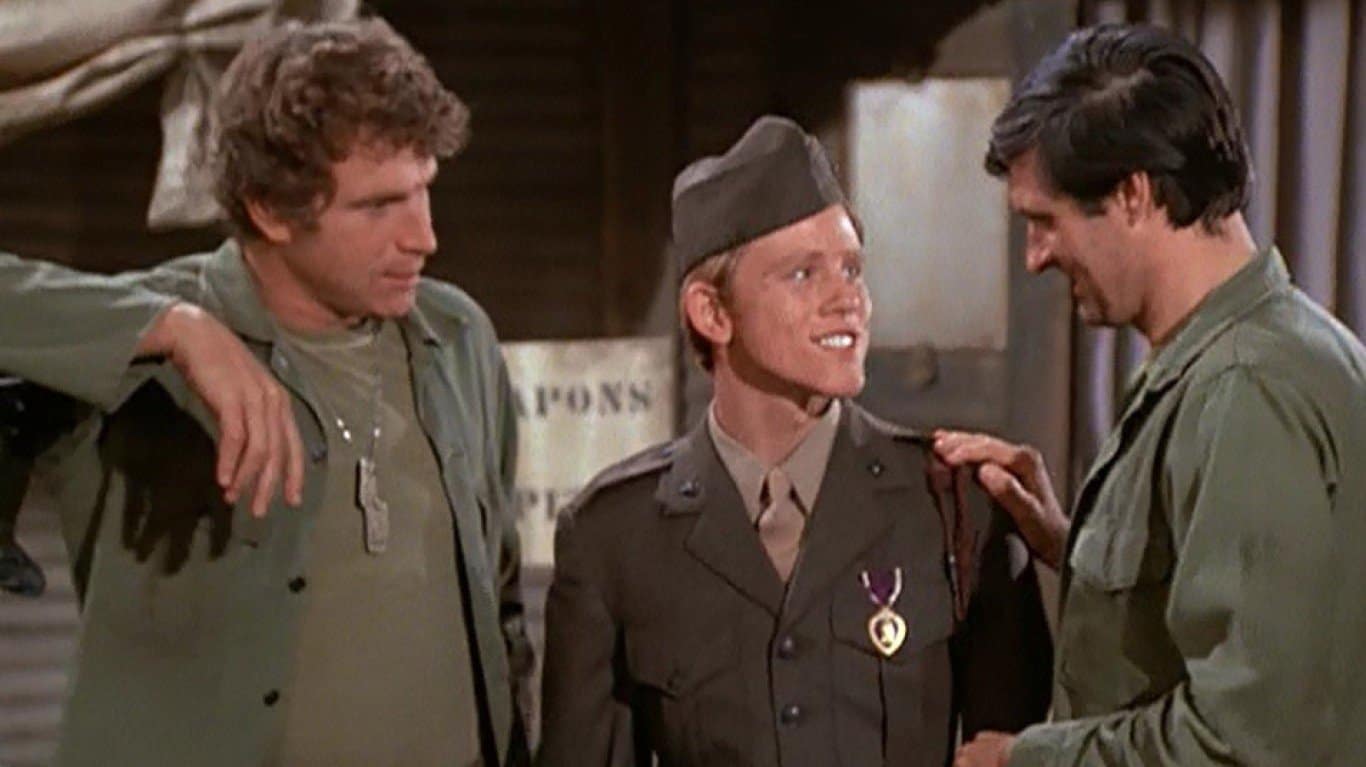There is no better way to end a long day than by spending the evening watching your favorite sitcoms on Netflix or whatever streaming service you prefer.
There may be some classic comedies that you have missed in your streaming ventures, though. These old shows deserve some love, so let’s explore some classic sitcoms that every American should watch.
Many of these sitcoms feature famous duos. Click here for a look at the 34 most iconic duos in TV history.
The First Sitcom

The first situation comedy appeared on American television on November 18, 1947. “Mary Kay and Johnny” starred a real-life married couple (Mary Kay and Johnny Stearns). It aired on the DuMont Television Network, and later on CBS and then NBC. The series was set in Greenwich Village and focused on the zany Mary Kay and her straight-laced husband, Johnny. It was on the air until 1950. The program began as a 15-minute show and later expanded to the familiar 30-minute format many sitcoms still follow today.
“Mary Kay and Johnny” was the first American TV sitcom, which is groundbreaking in and of itself. However, the show also provided numerous other firsts. It was the first program to show a couple sharing a bed. It was also the first television program to feature a pregnant character.
If you’re wondering why you’ve never heard of this innovative, trailblazing show, it is probably because there are almost no video archives of the program in existence. In the show’s early days, it was broadcast live and not recorded. As it progressed, kinescopes of the live episodes were recorded to be aired on the West Coast, but those recordings were not saved. Kinescopes were notoriously poor in quality.
There was also quite a different mindset about television in the 1940s. Programs were viewed as commodities that were virtually worthless after they had been broadcast, so preserving these recordings was simply not a priority. Plus, there was a financial motivation to destroy kinescopes to recover the silver they contained. No one was thinking about syndication, DVDs, streaming services, and the like. Only one full episode of “Mary Kay and Johnny” from 1949 is known to exist, along with a few fragments from a small handful of other episodes. However, while we can’t watch “Mary Kay and Johnny” today, we can appreciate the shows that followed in this first sitcom’s pioneering footsteps.
Classic Sitcom Rankings

To compile this list of classic sitcoms every American should watch, 24/7 Tempo referenced the Tomatometer scores on Rotten Tomatoes, an online movie and TV review aggregator. We also referenced sitcoms with the highest ratings on IMDb, an online movie and television database owned by Amazon. Furthermore, we consulted a list of the best sitcoms of all time from Rolling Stone, an American pop culture magazine, as well as “TV Guide’s 50 Greatest TV Shows of All Time,” a list published in the May 4–10, 2002 issue of TV Guide. Sitcoms that scored high in all of these outlets are at the top of our list. To finalize the list, we exercised editorial discretion as we weighed, among other things, how each sitcom influenced or changed the television medium and the lasting cultural impact of each show.
This list is limited to American sitcoms, so classics such as “Fawlty Towers” and “Only Fools and Horses” are not included. Also, as this is a list of classic sitcoms, only shows that debuted before 2000 were considered. This is not to say that sitcoms such as “The Office” and “Parks and Recreation” haven’t earned recent classic status (they absolutely have!), but we are highlighting older shows that have stood the test of time through multiple generations.
“Bewitched”
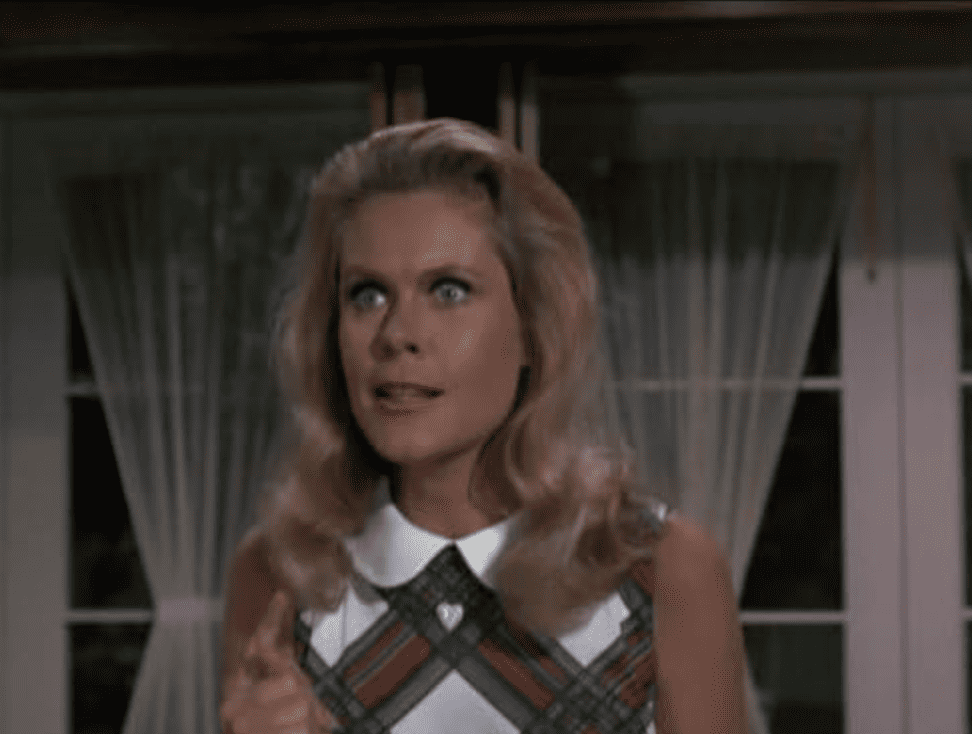
- Debut: September 17, 1964
- Number of Seasons: 8
- Where to Watch: Tubi, Sling TV, Philo
“Bewitched” was a sitcom that mixed in a bit of mild science fiction. Samantha Stephens (Elizabeth Montgomery) was a witch who was married to a mortal human being named Darrin (played in early seasons by Diсk York and later by Diсk Sergeant).
Samantha did not disclose her true identity to Darrin until after the two were married. Darrin insisted on living a normal life and Samantha agreed to keep her supernatural identity a secret. However, she was often forced to go against Darrin’s wishes and employ witchcraft to deal with complicated situations.
Samantha’s mother, Endora (Agnes Robertson Moorehead), was wholeheartedly opposed to the marriage, believing that a simple mortal was not worthy of marrying her daughter. The problematic mother-in-law often meddled in the Stephens’ marriage, casting spells that created never-ending burdens, especially for Darrin. Samantha was always there to save the day, though. Through a simple twitch of her nose (a move that came to be known as the “witch twitch”), Samantha used her powers to set things right again.
“Bewitched” made its mark with its creative premise and the masterful performances of its actors. While it is far from the most socially outspoken sitcom on this list, it did not shy away from making a statement. For example, in the ‘Sisters at Heart’ episode in season 7, the show addressed racism and opposition to interracial friendship and marriage. In the episode, Samantha’s daughter, Tabitha (Erin Murphy), cast a spell so that she and her friend Lisa, who was black, could have polka-dotted faces, making them both black-and-white.
“Barney Miller”
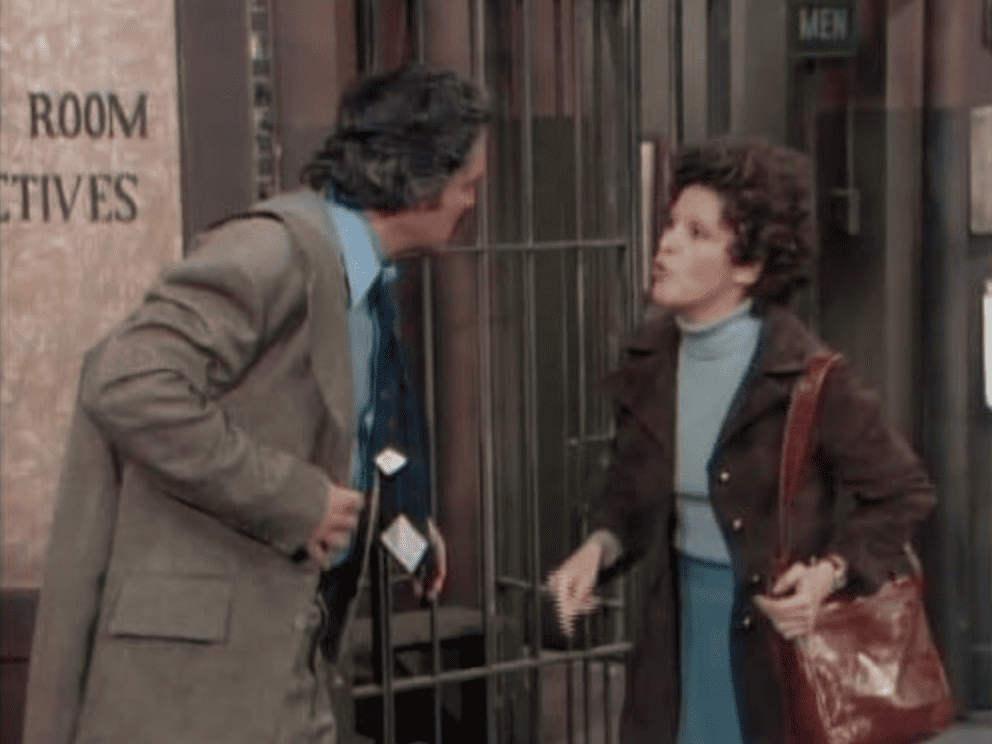
- Debut: January 23, 1975
- Number of Seasons: 8
- Where to Watch: Tubi, Sling TV, Philo
“Barney Miller” focused on police officers in NYPD’s 12th Precinct, led by Captain Barney Miller (Hal Linden). While it is a “cop show,” the program does not feature car chases, hostage standoffs, and other action-based scenarios. In fact, the officers are rarely shown outside of the Greenwich Village police station. Paperwork is often the center of their work-a-day lives. That, and the notoriously bad coffee that was mentioned in seemingly every episode.
Captain Miller was often frustrated by the bureaucratic red tape that hampered his department. His efforts at promotion also seemed to be thwarted at every turn. Rather than objecting to this portrayal, real-life police officers often appreciated and applauded the depiction of their profession. It has been hailed as one of the most realistic “cop shows” to ever grace the airwaves.
While Linden was the show’s star, the diverse ensemble cast made the sitcom into a classic. The show featured the crotchety old Jewish-American Philip K. Fish (Abe Vigoda), the intelligent, but arrogant, African-American Detective Ron Harris (Ron Glass), the over-zealous Polish-American Detective Stanley “Wojo” Wojciehowicz (Max Gail), the cerebral wiseguy Japanese-American Nick Yemana (Jack Soo), and the ever-struggling Puerto Rican Chano Amanguale (Gregory Sierra). This diverse cast, as well as the show’s New York City setting, provided endless comedic fodder, but also a platform to address controversial topics.
The show also featured one of the most underrated theme songs of all time. Chuck Berghofer’s grooving bassline in the “Barney Miller” theme song is, well, groovy…as all 1970s TV themes should be.
“The Donna Reed Show”
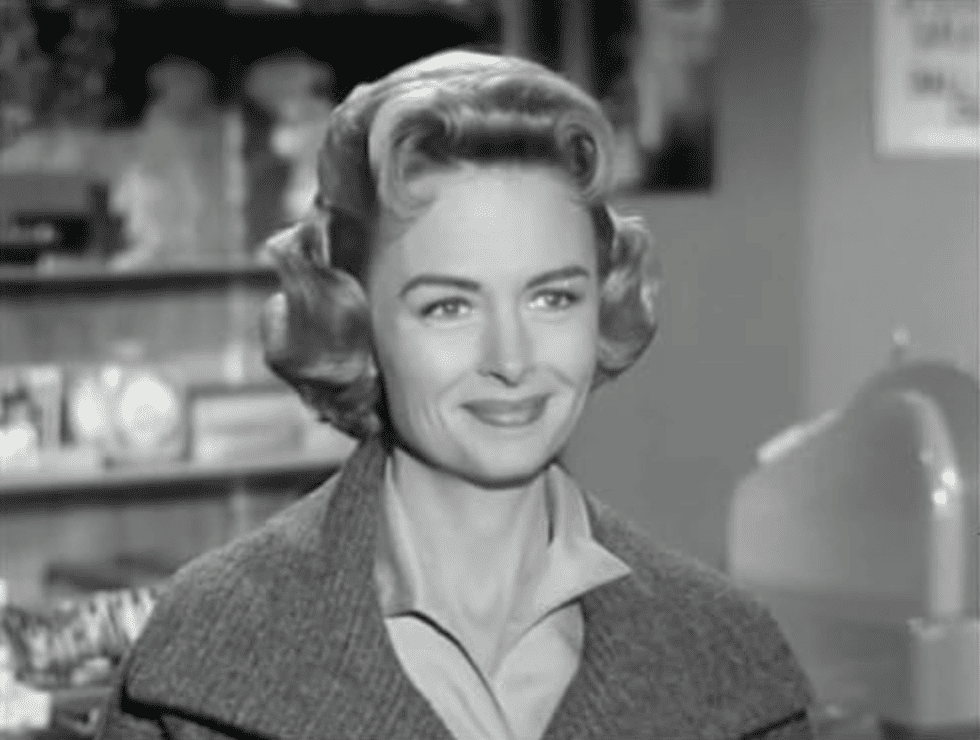
- Debut: September 24, 1958
- Number of Seasons: 8
- Where to Watch: Tubi, Pluto TV, Peacock, The Roku Channel, Prime Video
“The Donna Reed Show” centers on a nuclear family, a sitcom template that has been replicated countless times over the years. However, “The Donna Reed Show” was the first family sitcom to feature a woman as the star.
The show centered on the life of the Stone family, a middle-upper-class family in the fictional Midwestern town of Hilldale. Donna Stone (Donna Reed) was married to a pediatrician named Alex (Carl Betz). They had two teenage children, Mary (Shelley Fabares) and Jeff (Paul Petersen).
Much of the sitcom’s comedic plotlines arose from married life, teenage angst, and other “safe” domestic issues. However, the show was not afraid to occasionally tackle weightier topics. Women’s rights were always an undercurrent of the show and, at times, they were front and center. The final season even dealt with drug addiction, quite the taboo subject for the time period.
“Sanford and Son”
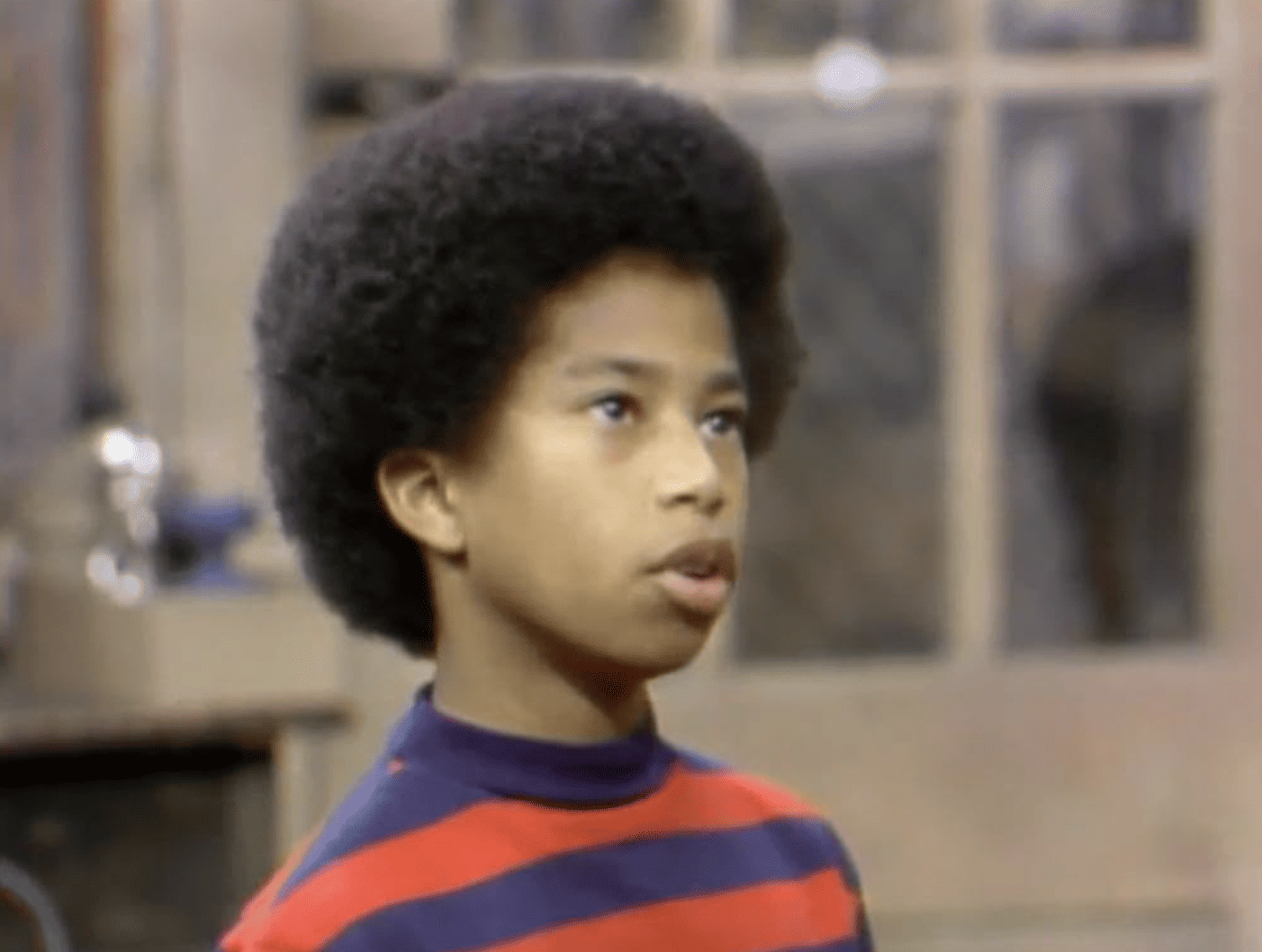
- Debut: January 14, 1972
- Number of Seasons: 6
- Where to Watch: Philo, Pluto TV, Peacock
Norman Lear, who passed away on December 5 at the age of 101, is a name that will come up several times on this list, which is only right considering he is one of the most iconic television producers in history. “Sanford and Son” was Lear’s masterful adaptation of the British sitcom, “Steptoe and Son.”
The show featured a widower named Fred Sanford (Redd Foxx) and his adult son, Lamont (Demond Wilson). Fred and Lamont were co-owners of “Sanford and Son,” a junk dealership they operated out of their home in the Watts neighborhood of Los Angeles.
Fred’s wife, Elizabeth, had died over two decades before the setting of the show. Fred and Lamont both missed her terribly. In moments of exasperation, Fred would look heavenward, clutching his chest as he feigned a heart attack, and say variations of, “This is the big one! You hear that, Elizabeth? I’m comin’ to join ya, honey!”
Lamont was in his mid-thirties and wanted to be independent, but he didn’t have the heart to leave his widowed father on his own, especially considering Fred’s penchant for falling into dubious get-rich-quick schemes.
While Foxx’s acid tongue was well-known from his standup career, his rhetoric had to be somewhat tamed to make it past network censors. Still, the show featured razor-sharp language. For example, Fred always had something derogatory to say when his deeply religious sister-in-law, Esther (LaWanda Page), showed up. In addition to these types of insults, hyper-charged racial dialogue was a staple of the show. The N-word was used in several episodes but was later edited out for syndication.
In one classic scene, Fred was questioned by a police officer about an alleged robbery. When the officer asked if the perpetrators were “colored,” Fred thought for a moment and then responded, “Yeah…white.”
While railing against the prevalent racism that he encountered, Fred was well-known for his own bigotry. His son, Lamont, often tried to temper his father’s fiery bombasts.
The show broke new ground for African-American actors in leading sitcom roles. It also featured what many believe to be the greatest TV theme song ever composed. Quincy Jones’ song entitled, “The Streetbeater,” is the iconic soundtrack that proceeds each episode of this controversial and hilarious sitcom.
“Family Ties”
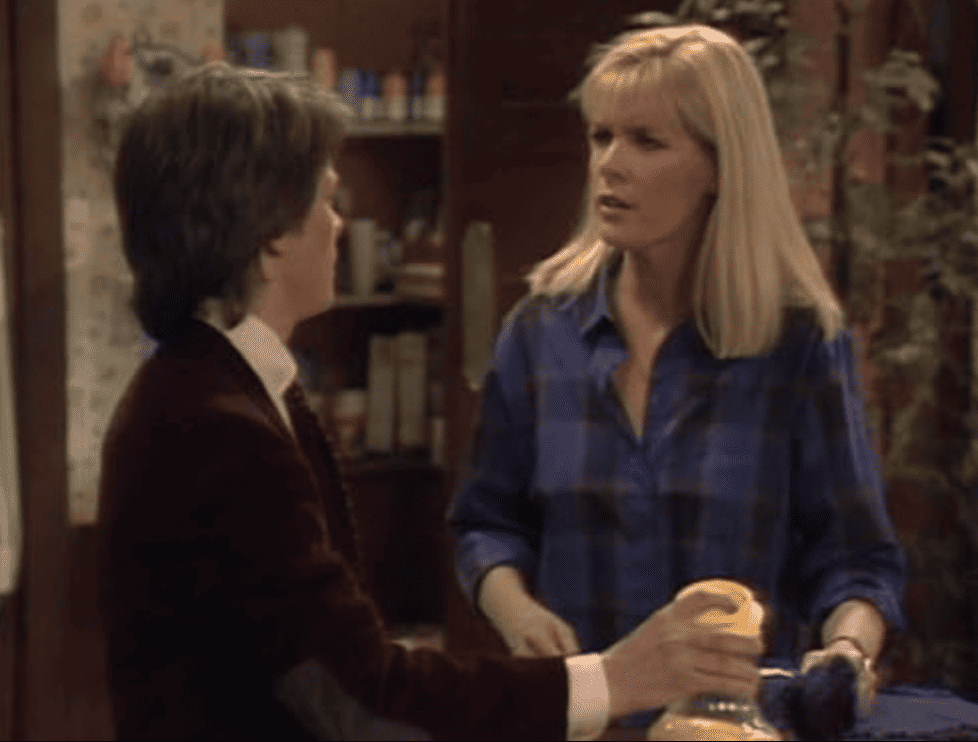
- Debut: September 22, 1982
- Number of Seasons: 7
- Where to Watch: Pluto TV, Paramount+, YouTube, Prime Video, The Roku Channel
“What would we do, baby, without us? Sha, la, la, la.” So sang Johnny Mathis and Deniece Williams in a song that came to be best known as the theme for “Family Ties.”
Family sitcoms were popular throughout the 1980s, but few were as beloved as “Family Ties.” The show centered on the Keatons, a nuclear family in Columbus, Ohio. Steven (Michael Gross) and Elyse Keaton (Meredith Baxter) were raising three children: Alex (Michael J. Fox), Mallory (Justine Bateman), and Jennifer (Tina Yothers). Later in the series, the Keatons welcomed a fourth child, Andy (Brian Bonsall).
While many of the show’s themes derived from everyday domestic life, there was always a line of political commentary and tension. Steven and Elyse were baby boomers and former hippies. They clashed often with their eldest child, Michael, who was a Reagan Republican. Mallory, on the other hand, was apolitical and was concerned with fashion and other more traditional teen issues. Jennifer was athletic and really just wanted to have a normal childhood.
The show provided lots of laughs as these divergent worldviews all coexisted in the framework of this loving family.
“The Adventures of Ozzie and Harriet”
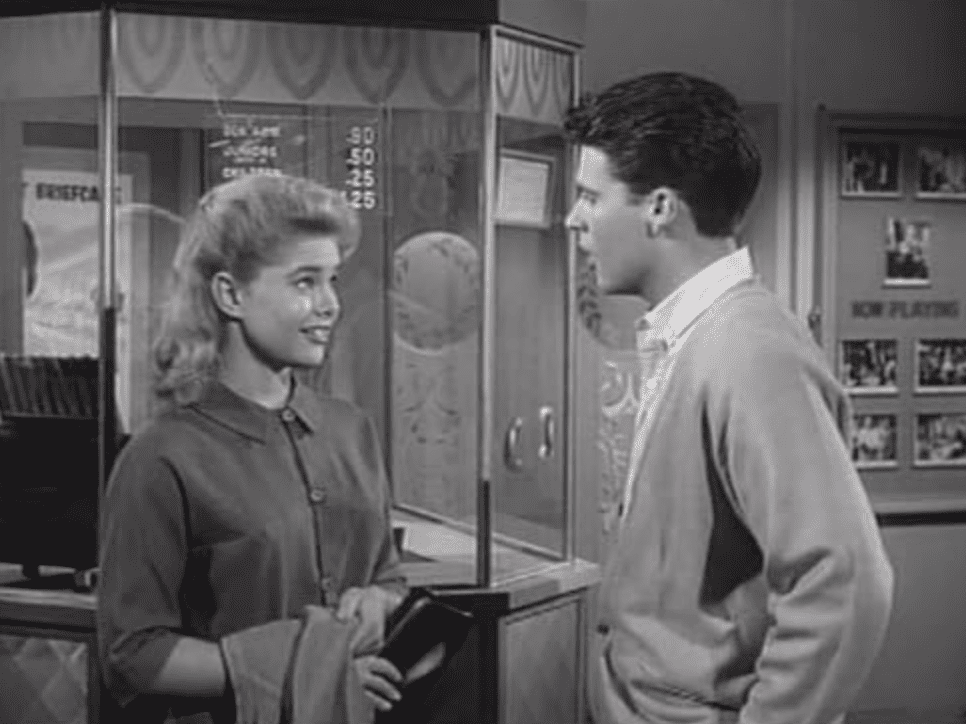
- Debut: October 3, 1952
- Number of Seasons: 14
- Where to Watch: Peacock, PLEX, Tubi, The Roku Channel, Sling TV
“The Adventures of Ozzie and Harriet” represented a turning point in American entertainment as it bridged the gap between radio and television. The show featured the real-life Nelson family. Ozzie and Harriet Nelson, and their sons David and Ricky, starred in the sitcom. The family’s actual home was even featured in the show.
The sitcom’s roots date back to “The Red Skelton Show,” a wildly popular American radio show. After Red Skelton was drafted, the radio version of “The Adventures of Ozzie and Harriet” was launched in 1944.
The television sitcom debuted in 1952 and was on the air until 1966. It was the longest-running comedy series in history until it was surpassed by “The Simpsons.”
The show is a stereotype of the 1950s in many ways. It does not transcend time in the way that many other shows on this list do. However, its importance in the development of television is indisputable.
“The Bob Newhart Show”
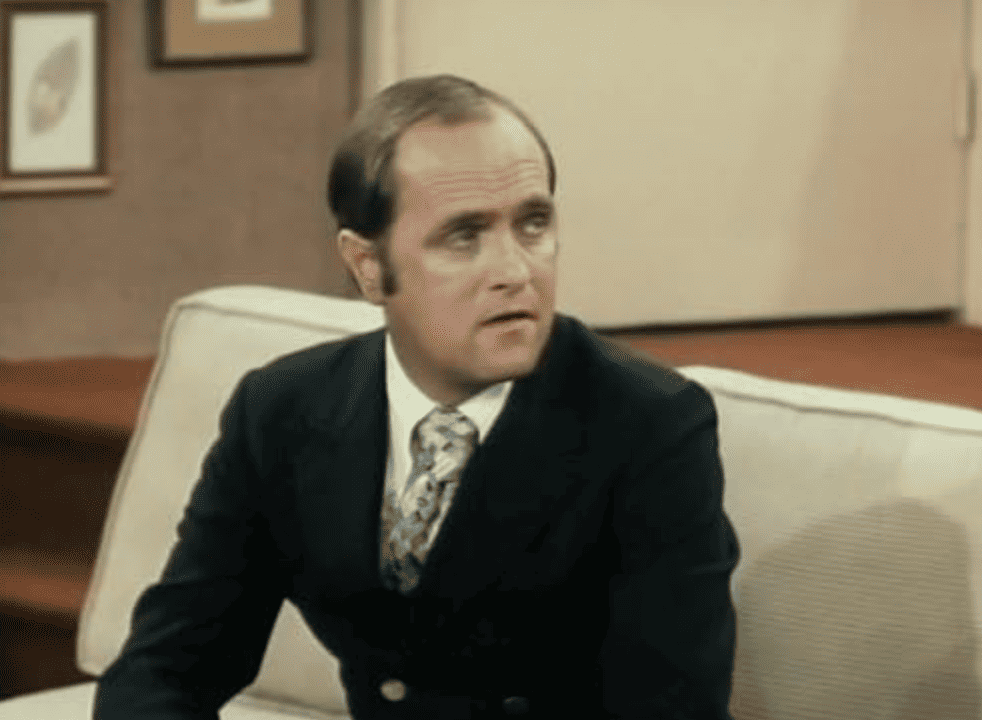
- Debut: September 16, 1972
- Number of Seasons: 6
- Where to Watch: Prime Video
While many sitcoms feature zany main characters with over-the-top personas, Bob Newhart brought the exact opposite to his eponymous show. Newhart is a master of deadpan comedy, with a unique halting, stammering style that he perfected while performing stand-up. He brought this art form to “The Bob Newhart Show.”
Newhart’s character, Bob Hartley, was a psychologist in Chicago. He often played his character as the straight man to his schoolteacher wife, Emily (Suzanne Pleshette), as well as his friends, neighbors, colleagues, and patients.
“The Bob Newhart Show” broke new ground as it derived much of its comic material from the subtleties of everyday life. If that sounds a bit like the format of other sitcoms, say “Seinfeld,” for instance, you’re right. Newhart was a pioneer of this type of observational humor.
He also parlayed his style into another sitcom. “Newhart” aired from 1982-1990. On the surface, the two shows seemed to have little in common, other than Newhart as the lead surrounded by a supporting cast of delightfully quirky characters. (“Hi. I’m Larry. This is my brother Darryl, and this is my other brother Darryl.” If you know, you know.) However, the two sitcoms were more linked together than they seemed, as revealed in the final episode of “Newhart” which provided a plot twist for the ages.
“The Golden Girls”
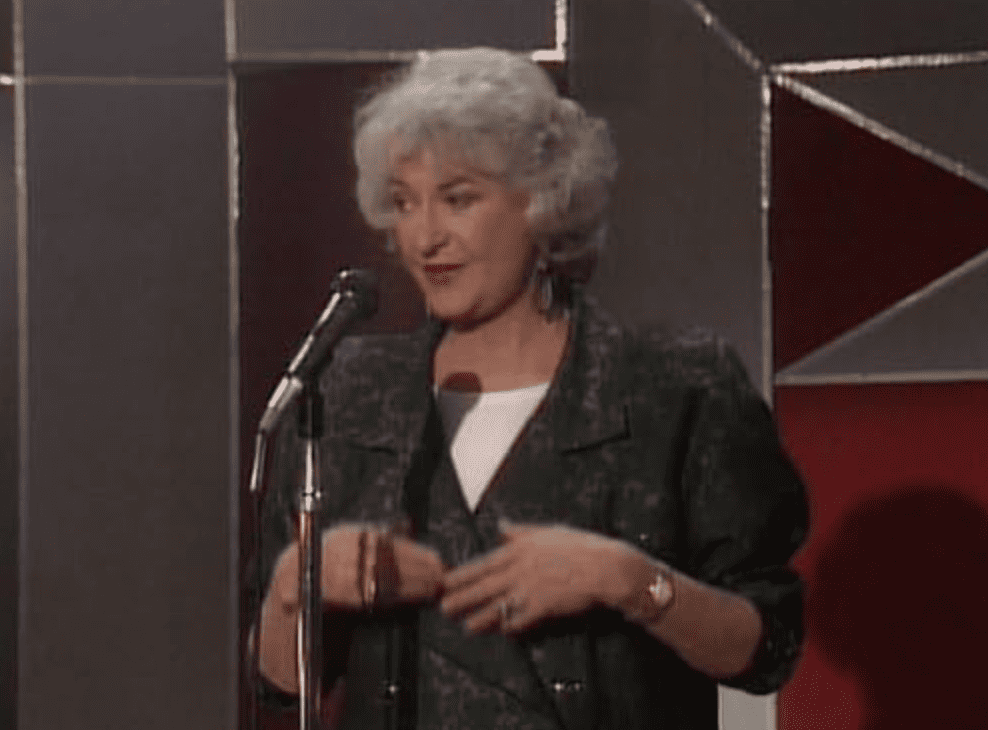
- Debut: September 14, 1985
- Number of Seasons: 7
- Where to Watch: Hulu, Sling TV
“The Golden Girls” brought a strong counterpoint to the 1980’s obsession with youth. The show centered on four older women who were all divorced or widowed. The foursome, who shared a house in Miami, consisted of the worldly and wise Dorothy Zbornak (Bea Arthur), dim-witted but lovable Rose Nylund (Betty White), man-hungry Blanche Devereaux (Rue McClanahan), and sharp-tongued Sophia Petrillo (Estelle Getty).
As these four ladies navigated their way through their golden years, they often clashed with each other. For example, Dorothy’s eye-roll was almost audible whenever Rose launched into another story of her childhood in St. Olaf. Blanche’s promiscuous lifestyle was always good for a wisecrack. And then, there was Sophia. As part of the show’s backstory, Sophia suffered a stroke which damaged the part of her brain that acts as a censor. As a result, her scathing words were always unfiltered.
The mixture of these four ladies was pure 1980s comedy gold. It also provided a different framework for a family-based sitcom. While Sophia and Dorothy were mother/daughter, there was no biological connection between the other characters. However, no one could argue that these four weren’t a family.
The show also tackled a wide variety of ‘80s hot-button issues, such as AIDS, politics, sexuality, and ageism.
“The Abbott and Costello Show”
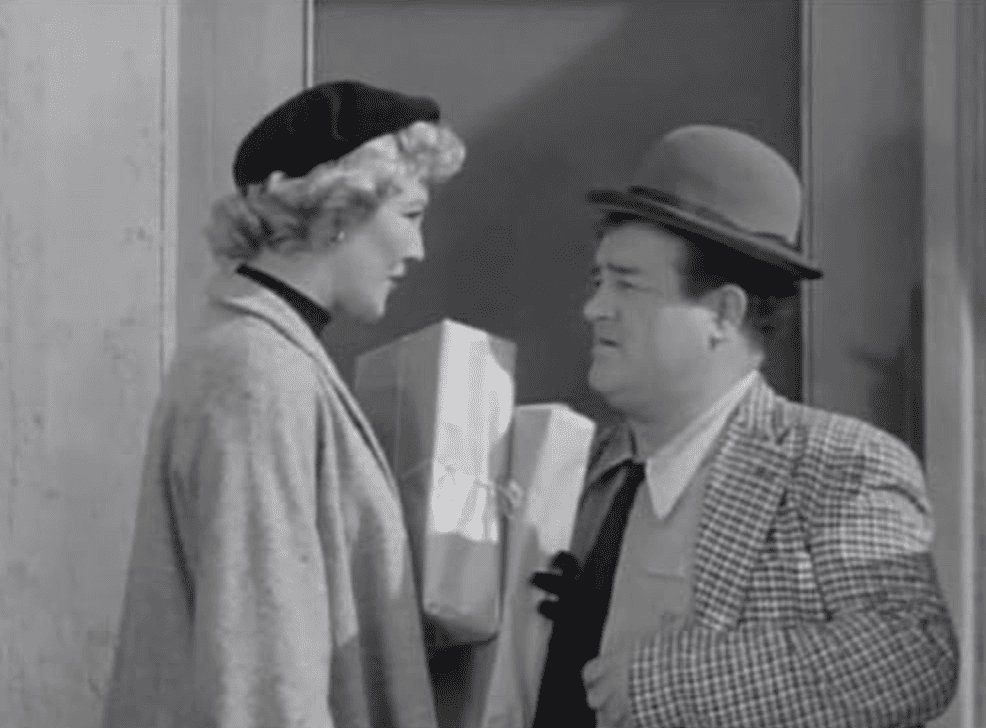
- Debut: September 1952
- Number of Seasons: 2
- Where to Watch: Peacock, The Roku Channel, Tubi
The comedy team of Bud Abbott and Lou Costello is legendary. Their “Who’s on first?” routine, for example, has become part of our cultural vernacular.
“The Abbott and Costello Show” was an opportunity for the duo to bring their puns, gimmicks, and slapstick comedy to the small screen. In the sitcom, Abbott and Costello played unemployed actors who were roommates in a Los Angeles boarding house. The plot of most episodes was secondary, though, to the gags that made Abbott and Costello famous.
The sitcom was not a network program, but instead was sold to about 40 local TV stations across the country. It debuted on these stations on various dates during the fall of 1952.
The show had a singular focus. It was not about heartwarming stories or life lessons. It was about one thing, and one thing only: comedy. Jerry Seinfeld noted that “The Abbott and Costello Show’s” focus on laughs instead of lessons was a primary influence that led to the creation of “Seinfeld.” It is one reason why this early sitcom is widely considered to be one of the most important shows of all time.
“Everybody Loves Raymond”
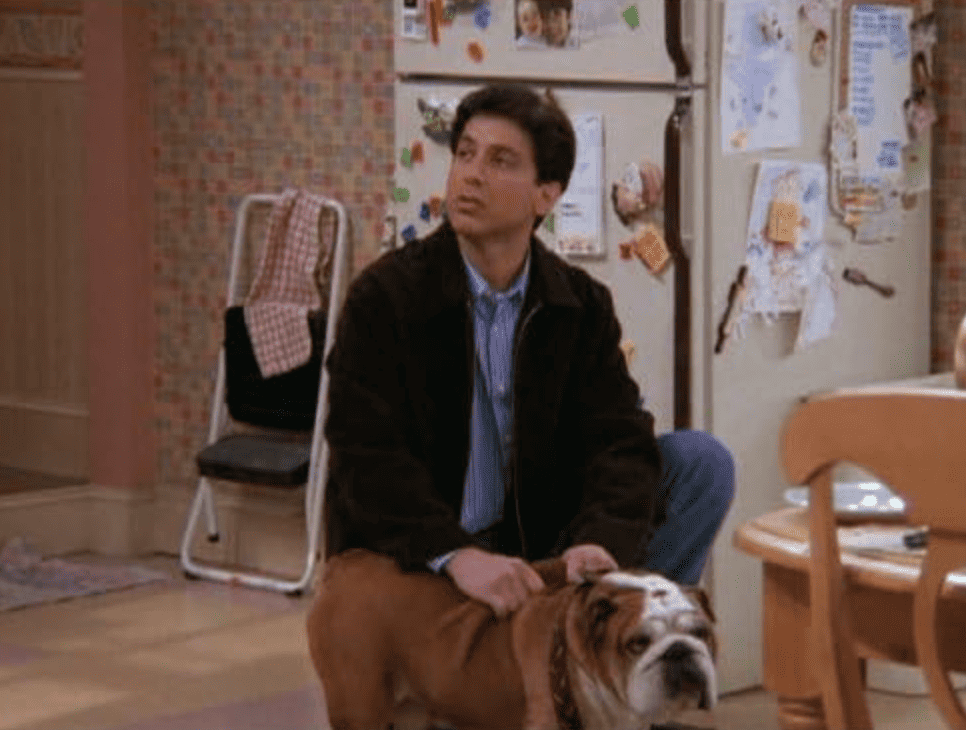
- Debut: September 13, 1996
- Number of Seasons: 9
- Where to Watch: Peacock, Philo, Paramount+, YouTube, Sling TV, The Roku Channel, YouTube, Prime Video
“Everybody Loves Raymond” was not groundbreaking, but rather was a reinvigoration of a beloved construct: the family sitcom.
The show was based on the comedy of Ray Romano, similar to how “Home Improvement” was based on the comedy of Tim Allen and “The Cosby Show” was based on Bill Cosby’s standup. (We know that the latter one is cringe-inducing. More on that later.)
Romano played Ray Barone, a Long Island sportswriter who lived with his wife, Debra (Patricia Heaton), and their three children. Ray’s parents lived right across the street. Frank (Peter Boyle) and Marie (Doris Roberts) visited (aka, intruded into) Ray and Debra’s house whenever they pleased. Marie’s unwelcome meddling and constant criticism of Debra, along with Frank’s gruff personality, provided a wealth of comedic situations in the show.
Ray’s older brother, Robert (Brad Garrett), was also a fixture. Robert never emerged from the shadow of his kid brother’s many accomplishments, although he did finally marry later in the show’s run. His wife, Amy (Monica Horan), tried unsuccessfully to prop up her husband’s fragile ego, but Robert could never get over the fact that, “Everybody loves Raymond.”
Casting is critical for a successful family sitcom, and this show featured actors who were perfect for their individual roles. Audiences not only laughed at the characters but came to love them, despite all their foibles and flaws.
“Everybody Loves Raymond” was the ultimate relatable family comedy. Anyone with a family can probably see themselves and their family members in parts of the show. In fact, Phil Rosenthal, the show’s creator, said, “Ninety percent of the stories on the show were based on real-life experiences.”
“The Jeffersons”
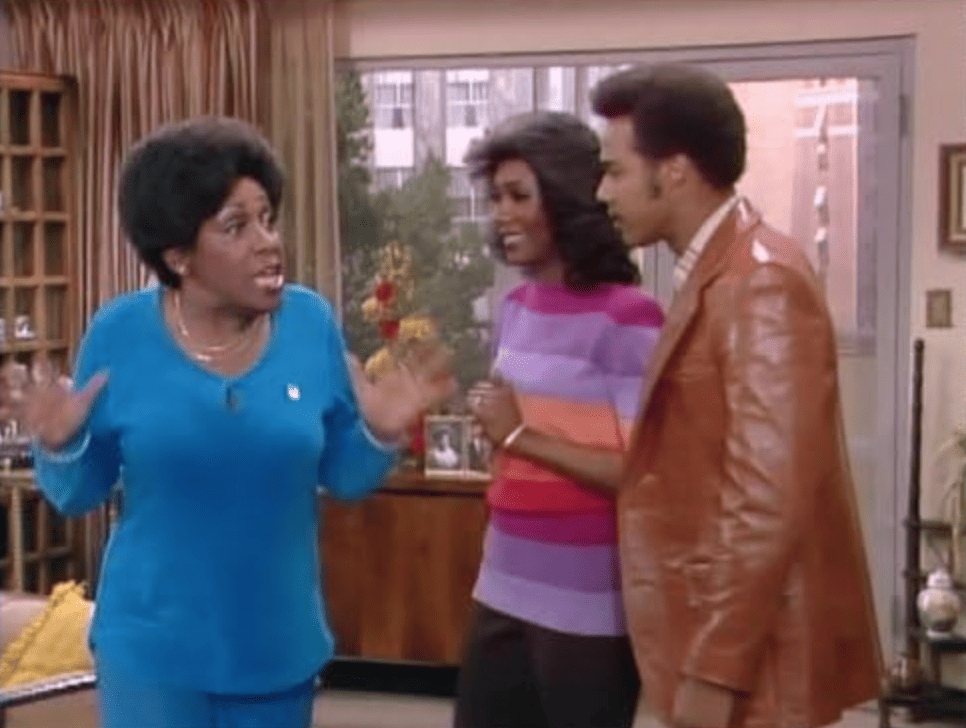
- Debut: January 18, 1975
- Number of Seasons: 11
- Where to Watch: Tubi
As noted earlier, Norman Lear is among the most prolific and important television producers in history. Lear created “Sanford and Son,” “All in the Family,” “Maude,” “One Day at a Time,” and “Good Times.” However, “The Jeffersons” was Lear’s longest-running show, airing from 1975 until 1985.
“The Jeffersons” was the second spinoff of “All in the Family” (“Maude” was the first.). The show featured George (Sherman Hemsley) and Louise “Weezy” Jefferson (Isabel Sanford). This African-American married couple had previously been neighbors of Archie and Edith Bunker on “All in the Family.” However, thanks to the success of George’s dry cleaning business, the Jefferson family was able to move from Queens to “a deluxe apartment in the sky” in Manhattan. This is reflected in the show’s iconic theme song, “Movin’ On Up,” sung by Ja’Net DuBois accompanied by a gospel choir. Most sitcoms with predominantly black casts portrayed families that were impoverished and struggling, but “The Jeffersons” flipped the script by telling the story of an affluent black family.
George Jefferson was essentially the African-American version of Archie Bunker. He was had a big mouth and he never kept his bigotry a secret. Racial epithets that would make our modern ears bleed were common in the show, particularly in the early seasons.
As with all of Lear’s sitcoms, “The Jeffersons” never shied away from addressing controversial issues. It was the first show to prominently feature an interracial married couple. Tom (Franklin Cover) and Helen Willis (Roxie Roker) were neighbors of the Jefferson family. Tom was white and Helen was black. George crassly referred to the Willis’ children as “zebras.” However, in a twist that George could have never imagined, the Jeffersons’ son, Lionel, eventually married the Willis’ daughter, Jenny.
Along with racism, the show also addressed suicide, gun control, alcoholism, and many more social issues during its remarkable 11-season run.
“The Andy Griffith Show”

- Debut: October 3, 1960
- Number of Seasons: 8
- Where to Watch: Pluto TV, YouTube TV, Prime Video, The Roku Channel, Philo, Sling TV, Paramount+
Andy Griffith was offered a pilot episode on “The Danny Thomas Show.” The pilot was so well-received that CBS offered Griffith his own show, and “The Andy Griffith Show” was born.
The show featured Griffith as the level-headed sheriff of the fictional small town of Mayberry. He was a widower who was raising a young son, Opie (Ron Howard), with the help of his Aunt Bee (Frances Bavier). And then there was Andy’s overzealous deputy, Barney Fife (Don Knotts). Andy and Barney were the only lawmen in Mayberry, although two officers were usually enough since very little crime was committed in the small town. The crime rate was so low, in fact, that Sheriff Taylor didn’t even carry a gun. Deputy Fife did, but he was only allowed to possess one bullet which he had to keep in his shirt pocket.
“The Andy Griffith Show” was filmed in Los Angeles but the show was set in rural North Carolina. Mayberry was not just the backdrop of the show, though. The town became an integral character itself. The wholesome yet quirky townspeople made viewers dream of pulling up stakes and moving to the bucolic hamlet of Mayberry.
While some sitcoms were centered on landing a joke, “The Andy Griffith Show” was about people, not punchlines. Knotts remarked that Griffith was known for saying, “If it sounds like a joke, throw it out.” It was all about the characters and the wisdom and joys of living life at a slower pace.
A visit to Mayberry feels nostalgic today, but it also elicited those same feelings when it first aired. In an interview on “The Today Show,” Griffith noted, “Well, though we never said it, and though it was shot in the ‘60s, it had a feeling of the ‘30s. It was, when we were doing it, of a time gone by.”
The show never ranked below seventh place in the Nielsen ratings during its entire run. It ended its eighth and final season as the number one show on television.
“Frasier”
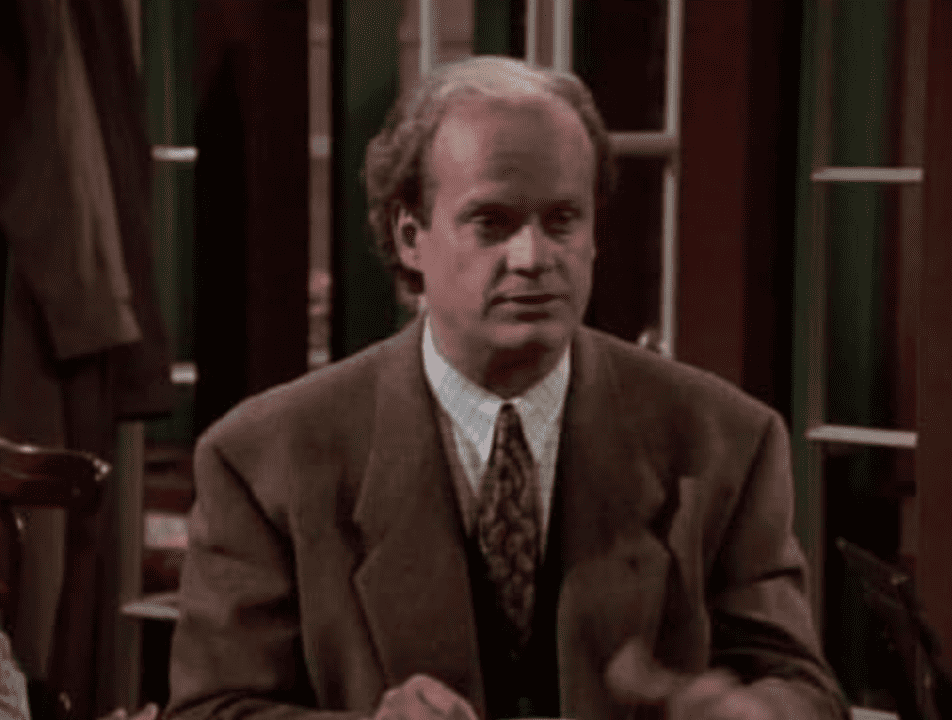
- Debut: September 16, 1993
- Number of Seasons: 11
- Where to Watch: Pluto TV, YouTube, Hulu, Prime Video, Paramount+, The Roku Channel
Countless television shows have launched spinoffs, but most of these spinoff shows enjoy modest success, at best. “Frasier,” however, might just be the greatest spinoff in television history.
“Cheers” was a hit show throughout the 1980s. One minor character, a psychiatrist named Dr. Frasier Crane (Kelsey Grammer), was introduced in the the third season. Frasier was planned as a temporary character, but the executives were so pleased with Grammer’s performance that he was given a recurring role on the show.
When “Cheers” ended in 1993, the show’s creators decided to move forward with a spinoff featuring Grammer. However, they wanted it to be completely different from “Cheers,” so they relocated Frasier from Boston to his hometown of Seattle.
Frasier hosted a call-in radio show where he offered psychiatric help to listeners with the help of his producer, Roz Doyle (Peri Gilpin). He lived with his father, Martin (John Mahoney), a former Seattle police officer who was wounded in the line of duty. Frasier hired a home healthcare worker, Daphe Moon (Jane Leeves), to help with his father’s physical therapy. He spent much of his time with his brother, Niles (David Hyde Pierce).
Frasier was fastidious and snobbish. He often clashed with his father, who was a blue-collar everyman. Martin’s chair, for example, was a pea-green and mustard-yellow relic of the 1960s. It was an affront to Frasier’s lavish apartment furnished with fine furniture, including a suede couch that was “an exact replica of the one Coco Chanel had in her Paris atelier.”
Frasier also found himself at odds with his father’s best friend, a Jack Russell Terrier named Eddie. The dog stared incessantly at Frasier, seeming to gaze directly into his soul.
Frasier did have an ally in Niles, who was even more uptight than his brother. While the two brothers were endlessly competitive, they also shared the same highbrow taste and disdain for their father’s chair, clothes, diet, and pretty much everything else he enjoyed.
Most viewers could not relate to Frasier’s upscale lifestyle (his Seattle apartment alone would have cost over one million dollars in 1993!), but the show still became one of the most popular sitcoms of all time. The writing is intelligent (even aristocratic) in tone, but the characters exude a warmth and humanity that resonated deeply with viewers.
A reboot of “Frasier” is currently in production. It is available exclusively on Paramount+.
“The Diсk Van Dyke Show”
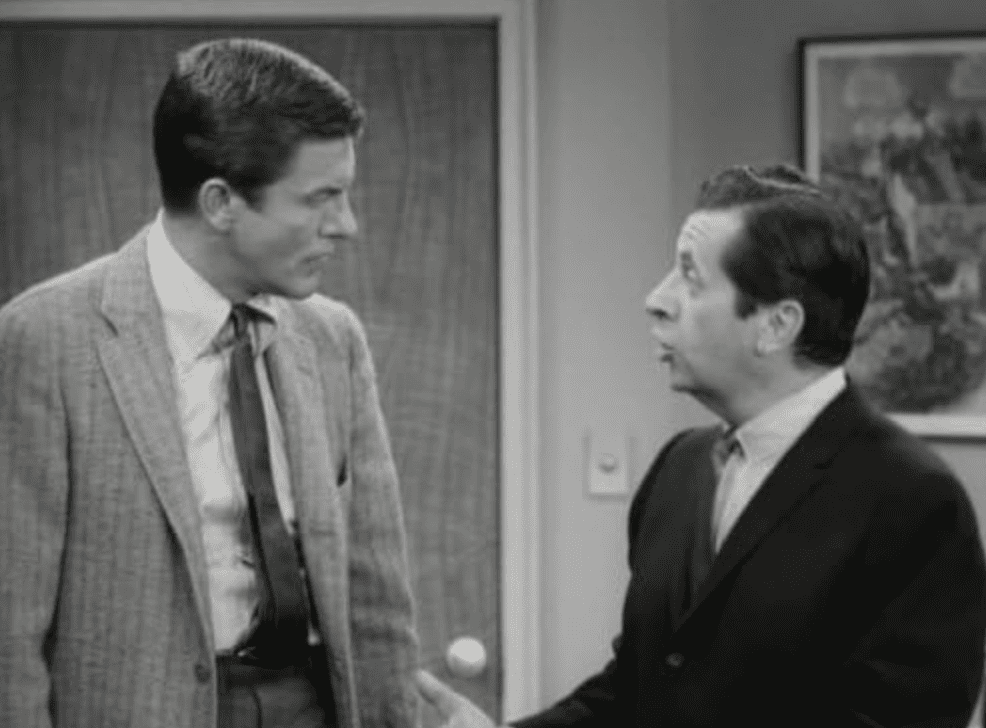
- Debut: October 3, 1961
- Number of Seasons: 5
- Where to Watch: fuboTV, YouTube, Philo, The Roku Channel, PLEX, Crackle, Sling TV, Pluto TV, Peacock, Tubi, Prime Video
Carl Reiner created “The Diсk Van Dyke Show” based on his time as head writer for Sid Caesar’s “Your Show of Shows.” The sitcom featured Rob Petrie (Diсk Van Dyke) who was a writer for the fictional variety program, “The Alan Brady Show.”
“The Diсk Van Dyke Show” alternated between Rob’s work life and his home life with his wife, Laura (Mary Tyler Moore). She was a former USO dancer whom Rob met while serving in the Army.
The show’s comedy is a mixture of Van Dyke’s slapstick antics (he trips over an ottoman during the opening credits in the show’s early years), the loving yet sometimes tense relationship between Rob and Laura, and Rob’s dealings with the crew of “The Alan Brady Show.”
The top three shows in 1960-1961 were Westerns. “The Diсk Van Dyke Show” was a renaissance of sorts for the TV sitcom. However, along with reviving the genre, it also broke some of television’s unwritten rules in the early ’60s. For example, Mary Tyler Moore often wore formfitting pants instead of dresses. Network executives were quite uncomfortable with this fashion choice, at first.
The show also disposed of the utopian life depicted in most 1950s sitcoms. The characters on “The Diсk Van Dyke” show had real relationships and real problems, which explains why it is an enduring classic to this day.
“All In The Family”
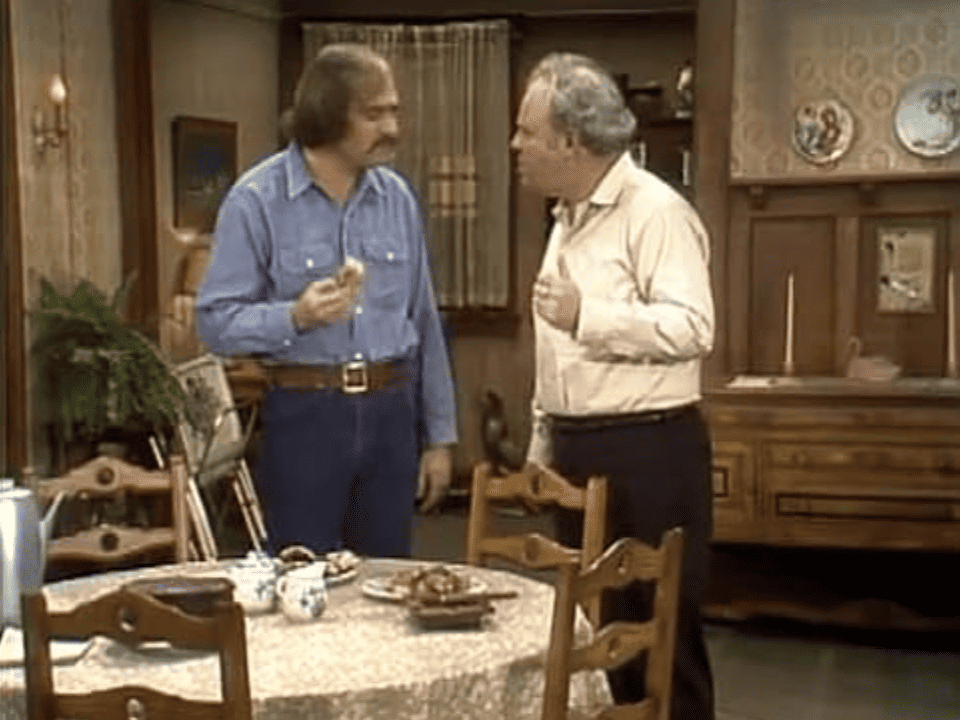
- Debut: January 12, 1971
- Number of Seasons: 9
- Where to Watch: Prime Video, Pluto TV, Hulu
CBS executives decided to scroll a disclaimer across the nation’s television screens before the first episode of “All In The Family” aired in January 1971. The disclaimer read, “Warning: The program you are about to see is ALL IN THE FAMILY. It seeks to throw a humorous spotlight on our frailties, prejudices and concerns. By making them a source of laughter, we hope to show–in a mature fashion–just how absurd they are.” Whether that warning was well-intentioned or simply an attempt by CBS to distance itself from what was about to follow is irrelevant. It alerted viewers that they were about to see something that had never been seen on television before. And, wow, were they ever right about that.
“All In The Family” centers on the Bunker family who lived in Queens. Archie (Carroll O’Connor) and Edith (Jean Stapleton) had one adult child, Gloria (Sally Struthers). She was married to Michael Stivic (Rob Reiner).
Archie was the show’s protagonist. He was a loud-mouthed, opinionated man who openly shared his racist and prejudiced views. Deep down, however, Archie was portrayed as a decent and loving person. This irreconcilable tension made the Archie character an inexhaustible source of material for the show’s writers.
The Bunker matriarch, Edith, was simple-minded but incredibly good and kind. She sought to mitigate Archie’s hot temper and bigoted views, often with little success. Archie often referred to her as a “dingbat.” Yet, as unhealthy as the relationship may have seemed, the two loved each other deeply.
Gloria was a feminist and was married to Archie’s main foil. Michael was a well-educated hippie. A product of the 1960s, Michael’s views sharply conflicted with those of his father-in-law. Archie nicknamed his son-in-law, “Meathead.”
Until “All In The Family,” most sitcoms depicted happy families that seem to live blissfully unattached from the pains and ills of the society around them. By contrast, “All In The Family” used those very pains and ills as the impetus for the show. No subject was off-limits. The sitcom addressed issues of racism, women’s rights, religion, abortion, the Vietnam War, homosexuality, antisemitism, and on and on.
Archie and Edith’s chairs from the Bunker living room are now immortalized in the Smithsonian. The chairs were donated at the end of the show’s eighth season, which was believed to be its last. When CBS ordered a ninth season, the chairs were already Smithsonian property. A mill in England was given the task of creating exact replicas of the chairs for the final season. It cost over $15,000 to recreate the two chairs that were purchased at a thrift store for under $10 prior to the show’s pilot episode.
Audiences went wild over the show. The laughs you hear in the sitcom are from a live studio audience, not laugh tracks which were standard for most sitcoms at the time. “All In The Family” was the number-one show on television from 1971-1976. It was the first show ever to sit atop the Nielsen ratings for more than five consecutive years. The groundbreaking, no-holds-barred sitcom is widely regarded as one of the most influential shows in television history.
“The Honeymooners”

- Debut: October 1, 1955
- Number of Seasons: 1
- Where to Watch: Pluto TV
“The Honeymooners” was created by Jackie Gleason, often known as “The Great One.” Though it only ran for 39 episodes in one season, it is hailed as one of television’s most seminal sitcoms.
The show centered on two married couples: Ralph (Gleason) and Alice Kramden (Audrey Meadows) and their friends Ed (Art Carney) and Trixie Norton (Joyce Randolph).
Ralph was a New York bus driver who had aspirations of a better life, but his money-making schemes inevitably backfired. He always managed to get himself into hot water, mostly with his wife. Ralph and Alice bickered constantly in the show, with Ralph often showing her his fist with the threat, “One of these days, POW!!! Right in the kisser!” While such a suggestion of domestic violence would raise red flags today, Alice knew that Ralph’s threats were empty. Her sharp, witty responses often put Ralph in his place. While their marriage was dysfunctional, the two certainly loved each other. Ralph routinely told Alice, “Baby, you’re the greatest.”
Ed was a sewer worker. He was Ralph’s best friend, although Ralph was often infuriated by his buddy’s seeming dimwittedness (even though Ed was actually more intelligent than Ralph). Ed regularly got caught up in Ralph’s schemes. Whenever Ed raised Ralph’s ire, he was forcefully thrown out of the Kramden’s apartment. Ed Norton is widely regarded as one of the greatest sidekicks in TV history.
As noted earlier, most 1950s comedies presented characters/families that seemed detached from the troubles of the world. Their idyllic lives had no basis in reality. Enter the Kramdens. They struggled mightily just to make ends meet. For the first time, many Americans saw a reflection of their own lives on TV, even if that reflection was comedically exaggerated.
“The Honeymooners” was the inspiration for the animated series, “The Flintstones.” The cartoon’s four main characters (Fred and Wilma Flinstone and Barney and Betty Rubble) so close mirrored those of “The Honeymooners” that Gleason considered suing Hanna-Barbera, but was dissuaded by his friends who told him that he didn’t want to go down in history as “the man who killed Fred Flintstone.”
“The Mary Tyler Moore Show”
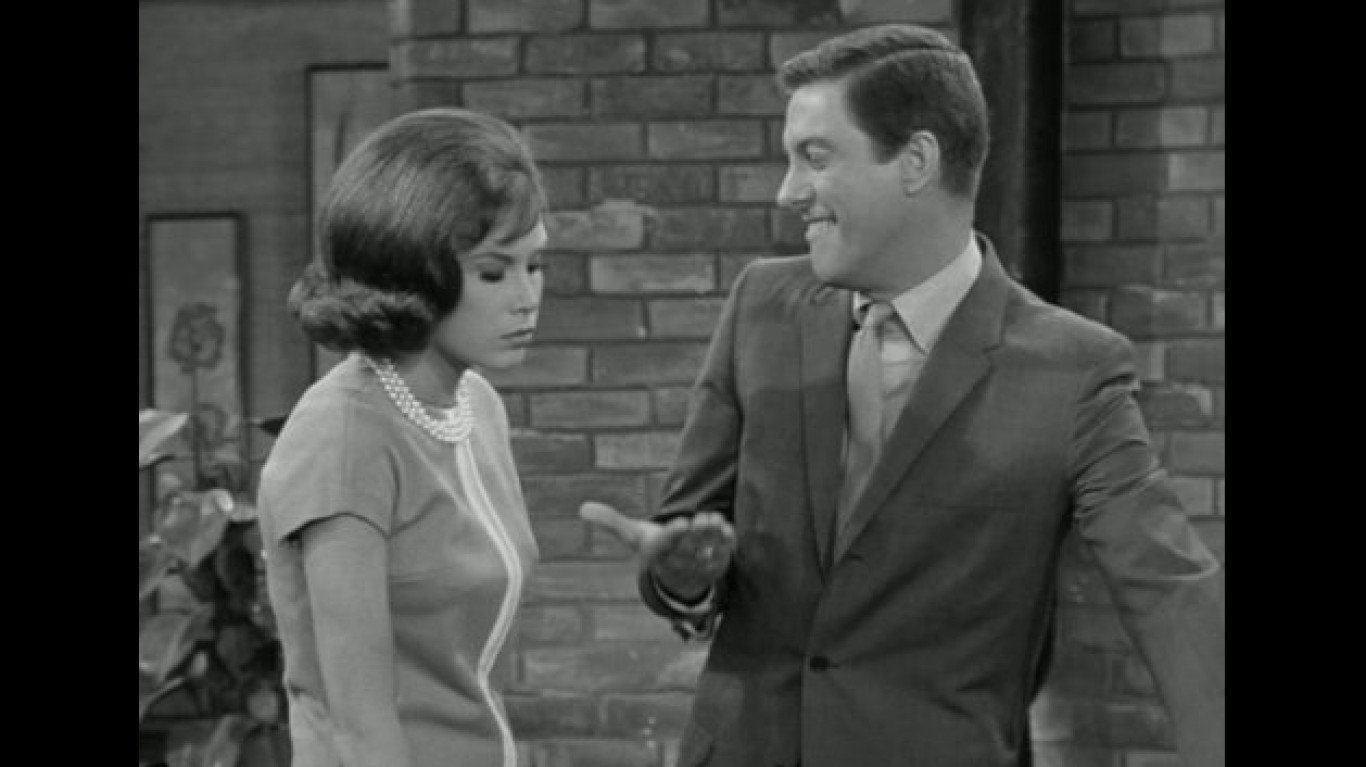
- Debut: September 19, 1970
- Number of Seasons: 7
- Where to Watch: Hulu, Prime Video
Mary Tyler Moore had a moderately successful career until her breakout role in “The Diсk Van Dyke Show” catapulted her to stardom. After her supporting role in that show, she became the star of her own sitcom in “The Mary Tyler Moore Show.”
The show centered on Moore’s character, Mary Richards, who was the first single, career woman to be the central star of a TV show. In the show, Mary moved to Minneapolis after breaking up with her fiancé. She landed a job as an associate producer of the evening news at a low-rated TV station.
The show’s cast was a who’s who of television royalty, including Ed Asner, Gavin MacLeod, Ted Knight, Cloris Leachman, Valerie Harper, Georgia Engel, and Betty White. The show launched three spinoffs, the most well-known of which was “Rhoda.”
Mary was an unmarried and independent woman, which was rare on 1970s television. Women’s rights were always at the forefront of the show, as were some men’s attitudes toward this new wave of feminism. In one of the show’s most famous scenes, Mary’s boss, Lou Grant (Asner), told her, “You know, Mary, you’ve got spunk.” Mary responded with, “Why, thank you, Mr. Grant,” to which Lou replied, “I hate spunk.”
The show marked a pivotal moment that paved the way for women to star in television shows instead of always being relegated to supporting roles.
“Friends”
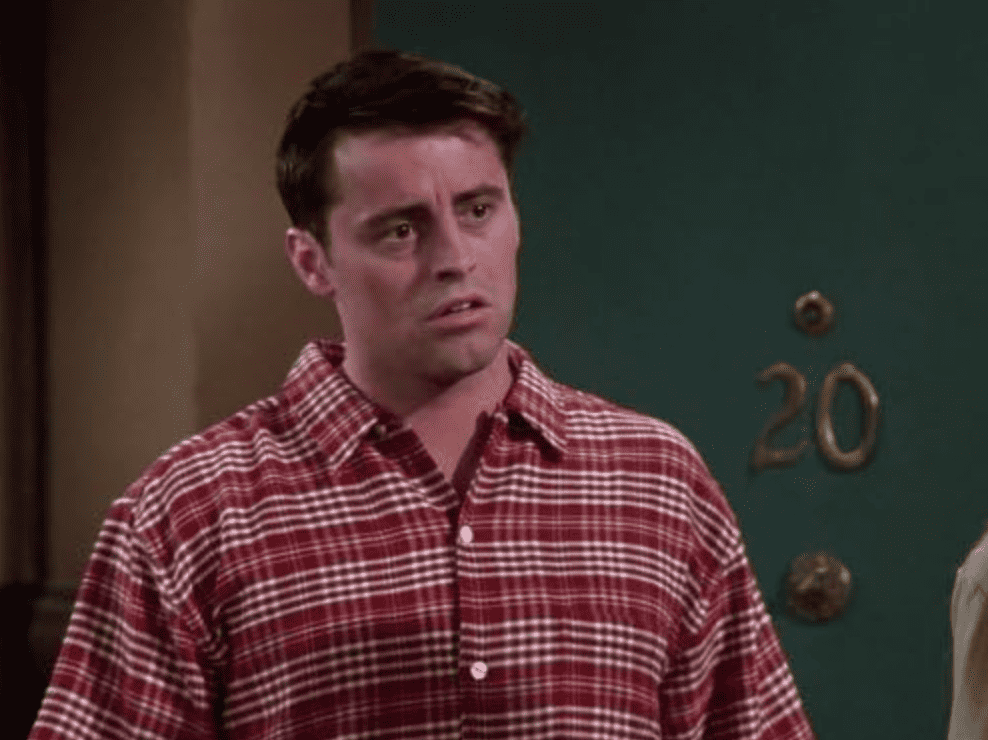
- Debut: September 22, 1994
- Number of Seasons: 10
- Where to Watch: Prime Video, Max, Hulu, Sling TV, YouTube TV, Prime Video
In the crowded field of 1990s sitcoms, “Friends” stands out largely due to the chemistry of its ensemble cast. The show centers on the daily lives of six young adults in New York City.
Rachel Green (Jennifer Aniston) grew up wealthy but had fallen out of favor with her father. To make ends meet, she worked as a waitress at Central Perk, the coffeeshop that was the setting for many of the sitcom’s iconic scenes. Rachel landed a job in the fashion industry in later seasons.
Monica Geller (Courtney Cox) was a chef and Rachel’s roommate. She was obsessive-compulsive and never recovered from past childhood traumas.
Ross Geller (David Schwimmer) was a paleontologist with numerous failed marriages. He had a high opinion of himself, stemming from how his parents doted over him during his childhood.
Chandler Bing (Matthew Perry) was the wealthiest of the six friends. He was also the most sarcastic, often using humor as a shield to deflect from past traumas.
Joey Tribbiani (Matt LeBlanc) was rather dimwitted but lovable. He also had a more active romantic life than any of the others.
Phoebe Buffay (Lisa Kudrow) was a masseuse and musician who was known to play her songs, such as “Smelly Cat,” in Central Perk. Her mother committed suicide when Phoebe was a teenager and she carried that trauma with her forever.
“Friends” dealt with enduring themes of friendship, conflict, romance, loss, and other struggles of early adulthood. Maybe it is best summed up in Monica’s words to Rachel in the first episode. Rachel had left a fiancé that she didn’t love and was now on her own. As she cut up the credit cards paid for by her well-to-do father, Monica reassured her by saying, “Welcome to the real world. It sucks. You’re gonna love it.” As so was born the epic ten-season run of “Friends.”
The show paved the way for so-called “hangout sitcoms” that centered on relationships between friends rather than family members. Some highly successful sitcoms that followed this framework include “How I Met Your Mother” and “The Big Bang Theory.”
52.5 million U.S. viewers tuned in to watch the series finale on May 6, 2004, making it the most-watched TV episode of the decade.
The world was recently stunned when Matthew Perry, one of the show’s stars, died in October at the age of 54.
“MASH”

- Debut: September 17, 1972
- Number of Seasons: 11
- Where to Watch: Hulu, Sling TV
“MASH” was adapted from the 1970 film of the same name. The show was set in the Korean War, although it was released nearly 20 years after the conflict ended. Its release did coincide with the Vietnam War, however, which fed into many of the show’s themes.
The sitcom centered on the staff of the 4077th, a Mobile Army Surgical Hospital (MASH) unit stationed in South Korea during the Korean War. The doctors, nurses, and support staff were almost all draftees, except for Colonel Potter (Harry Morgan) who would command the unit in the show’s later seasons.
The 4077th had an amazing success rate as they performed “meatball surgery” on countless young soldiers who were wounded in the war. This was no run-of-the-mill Army installation, though. Hawkeye Pierce (Alan Alda) and his compatriots always found new mischief, often at the expense of Margaret “Hot Lips” Houlihan (Loretta Swit) and Frank Burns (Larry Linville). Max Klinger (Jamie Farr) would do anything for a Section 8 discharge (a category of discharge for service members deemed mentally unfit for service), including dressing as the Statue of Liberty when General Douglas MacArthur visited the camp. The company clerk, “Radar” O’Reilly had an unexplainable clairvoyance, but also slept with a teddy bear.
The absurd shenanigans of the 4077th contrasted sharply with the despair of their circumstances. But the laughter could be instantly shattered by the dreaded announcement over the loudspeaker that choppers were arriving with more wounded soldiers.
The show is unquestionably the darkest comedy on the list. It dealt openly and graphically with the horrors and injustices of war during one of the most complicated and difficult times in American history.
The dramedy was on the air for 11 years, even though the actual Korean War only lasted three years. The two-and-a-half-hour series finale, “Goodbye, Farewell and Amen,” drew the largest audience in TV history up to that point. It remains the most-watched episode of any scripted series ever.
“Cheers”
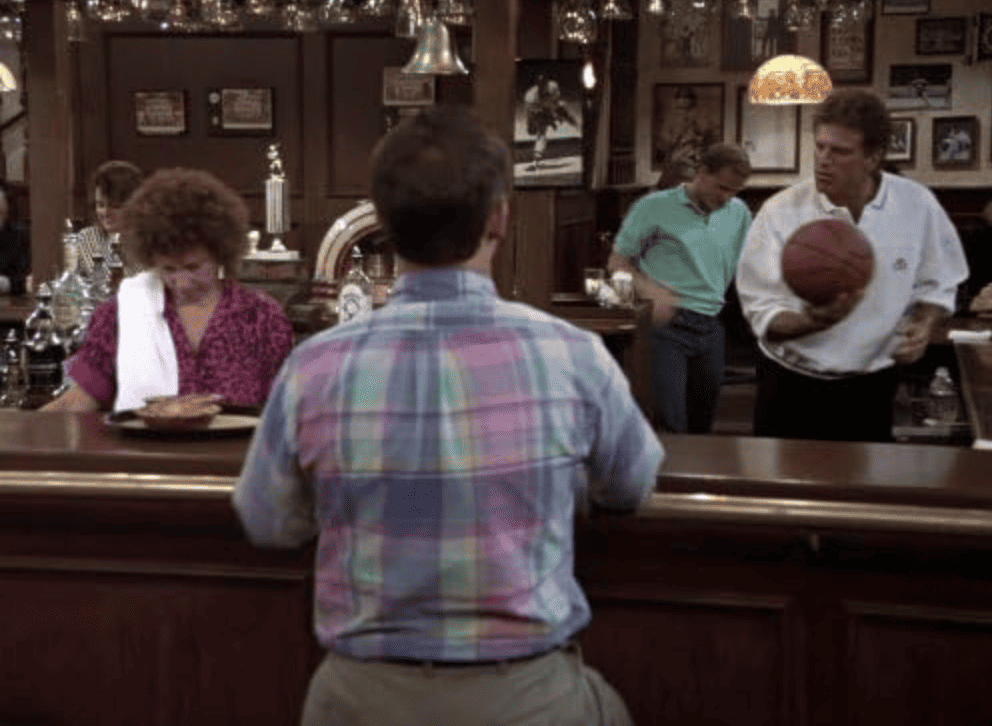
- Debut: September 30, 1982
- Number of Seasons: 11
- Where to Watch: Pluto TV, The Roku Channel, Hulu, YouTube, Paramount +, Prime Video
“A guy walks into a bar…” It’s the beginning of countless hackneyed jokes, but it also provided the premise for one of the most enduring sitcoms of all time: “Cheers.”
The show centered on a Boston bar owned by Sam Malone (Ted Danson). He was a former pitcher in Major League Baseball, but his alcoholism cost him his career. It was that alcohol addiction that led him to purchase the bar. The show unapologetically steered into difficult conversations. Along with Sam’s alcoholism, “Cheers” also addressed homosexuality, feminism, gambling, and infidelity.
As the bar owner, Sam was assisted by a variety of staffers through the years, including Diane Chambers (Shelley Long). She and Sam had an on-and-off relationship through much of the series’ early years. Other memorable staff members included “Coach” Ernie Pantusso (Nicholas Colasanto), Carla Tortelli (Rhea Perlman), Woody Boyd (Woody Harrelson), and Rebecca Howe (Kirstie Alley).
Of course, no bar could exist without patrons, and Cheers had a litany of memorable regulars including Norm Peterson (George Wendt), Cliff Clavin (John Ratzenberger), Frasier Crane (Grammer), and Lilith Sternin (Bebe Neuwirth).
The bar brought people together who would have likely never met under any other circumstances. Well-to-do people such as Frasier, Lilith, and Diane were thrown together with middle-class folks such as Carla, Norm, Cliff, and Woody. The class distinctions of this disparate group seemed to disappear when they walked through the doors of the bar.
This type of community is something we all hunger for. It is highlighted in the show’s theme song, which reminds us all that, “Sometimes you wanna go where everybody knows your name.” For 11 years, Cheers felt like just such a place.
“The Simpsons”

- Debut: December 17, 1989
- Number of Seasons: 35
- Where to Watch: FOX, Hulu, Disney+, YouTube TV, fuboTV, Sling TV
“The Simpsons” is the only show on this list that is still in production. However, when a show lasts 35 seasons (with the 36th season already ordered by the network), it is fair to call it a classic.
The show began as a series of animated shorts on “The Tracey Ullman Show.” After three seasons, “The Simpsons” was expanded into its own half-hour show.
The sitcom centers on the Simpson family. Homer (Dan Castellaneta) and Marge (Julie Kavner) are raising three children. Bart (Nancy Cartwright), Lisa (Yeardley Smith), and infant Maggie in the fictional town of Springfield.
The show is the gold standard for pop culture satire and parody. It has referenced everything from “Raiders of the Lost Ark” to “ALF.” Many of the cultural references in the show are so fast and subtle that casual viewers miss them.
“The Simpsons” has satirized and skewered virtually every segment of Western society. Liberals and conservatives are both fair targets. Issues such as guns, pollution, and immigration have been addressed. Unlike most families depicted in modern sitcoms, the Simpsons attend a local church. However, their evangelical neighbors, the Flanders, are unflatteringly caricatured. No one is exempt from the crosshairs of “The Simpsons,” which is one reason why the show is so beloved by so many.
“The Simpsons” is also famous for predicting the future. While the show’s writers aren’t actually psychic, it is worth noting that the animated sitcom did seem to predict the Trump presidency, a pandemic, smartwatches, the Disney-Fox merger, and many other events.
With over 750 episodes and counting, “The Simpsons” is the longest-running primetime show in TV history. With animated characters who never age and brilliant writing that continues to drive the show, it seems like the end is nowhere in sight.
“Seinfeld”
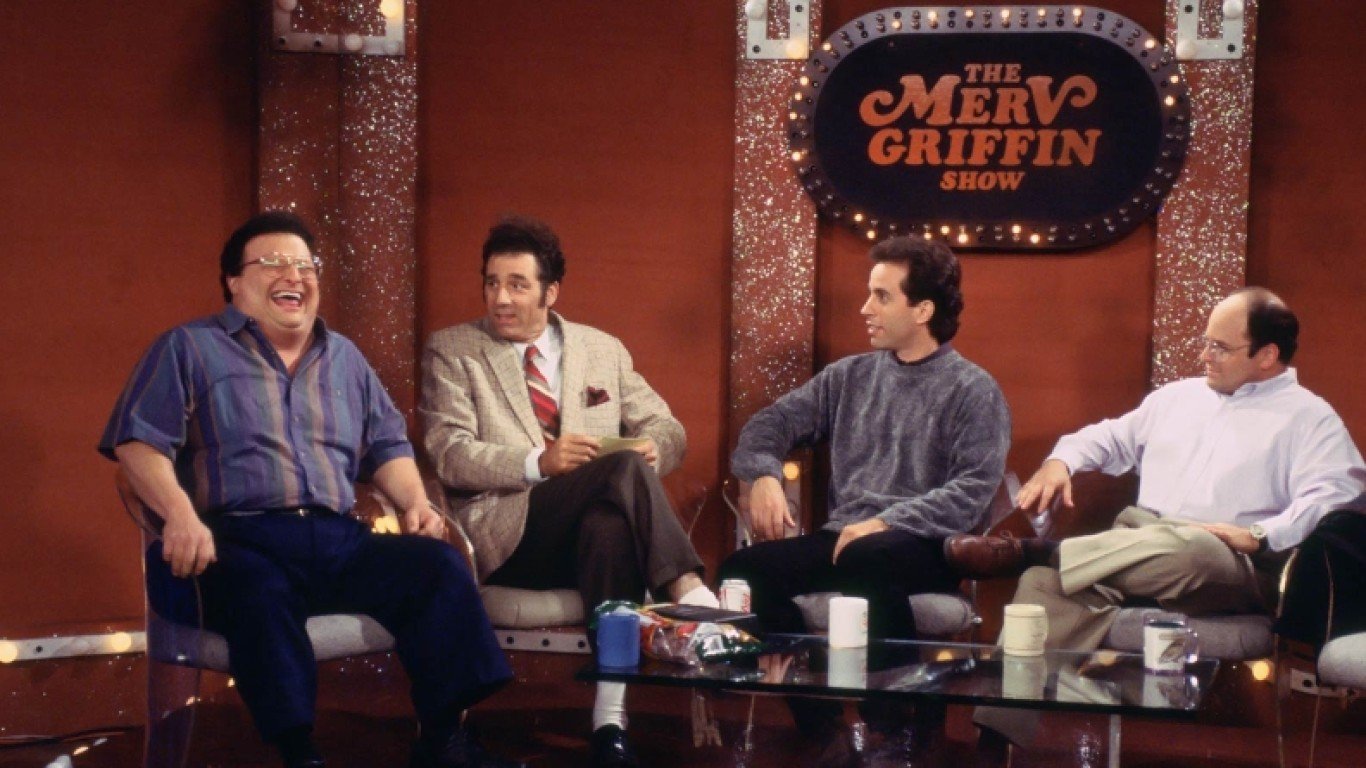
- Debut: July 5, 1989
- Number of Seasons: 9
- Where to Watch: Netflix, Sling TV
It is often described as “a show about nothing,” but that line from later episodes was never meant to describe the sitcom itself. In reality, the show was about something. Namely, it was about poking fun at the very worst of human nature.
“Seinfeld” featured an ensemble cast of four friends. Comedian Jerry Seinfeld played a fictionalized version of himself. His friends included his former girlfriend Elaine Benes (Julia Louis-Dreyfus), childhood pal George Costanza (Jason Alexander), and kooky neighbor Cosmo Kramer (Michael Richards). By any reasonable standard, these four friends were actually pretty terrible people. They said and did things that may fleetingly cross the mind of a rational person, but that person would certainly never act on such impulses. This foursome, however, would do just that. Whether it was faking a disability, mugging an elderly lady, bluntly telling a person that they needed a nose job, or participating in a cockfighting ring, these four did it all…and we couldn’t stop laughing at just how horrible they were.
The show was also known to, as Elaine put it, “pour over the excruciating minutiae of every single daily event.” That fixation on the subtleties and mundane events of everyday life was like nothing we had ever seen before. Some examples of this preoccupation and pettiness include the time George became obsessed with a missing box of raisins. Then there was the time when Elaine broke off a relationship because her boyfriend didn’t use appropriate punctuation. How about when Kramer drove a cable guy to the brink of insanity because of a simple scheduling snafu? Or Jerry breaking up with a woman because she ate her peas one at a time?
The ‘90s were chocked full of relationship sitcoms. Characters learned life lessons and grew closer to one another in many of these shows. “Seinfeld” was the antithesis of this construct. Larry David, the show’s co-creator alongside Seinfeld, said there was a “no hugging and no learning” rule on the show.
“Seinfeld” ended its 9 season run at the top of the Nielsen ratings, a feat that had only been accomplished by “The Andy Griffith Show” and “I Love Lucy.” Thanks to streaming services, the show is still wildly popular, even among young adults who weren’t alive during the show’s original run on NBC.
“I Love Lucy”

- Debut: October 15, 1951
- Number of Seasons: 6
- Where to Watch: Crackle, Pluto TV, Paramount+, YouTube, Prime Video, The Roku Channel
No sitcom was more consequential or influential than “I Love Lucy.” Lucille Ball and her husband, Desi Arnaz, starred in the show alongside Vivian Vance and William Frawley.
In the show, Ricky Ricardo (Arnaz) was a Cuban-American singer and bandleader in a nightclub. His wife, Lucy (Ball), dreamed of breaking into showbiz herself but lacked the talent needed to make the leap. Ricky just wanted Lucy to be satisfied with the life they had created, but she was always scheming up new ways to join the show at Ricky’s Tropicana Club.
The Ricardos’ neighbors and landlords, Fred (Frawley) and Ethel Mertz (Vance), were former vaudeville singers and dancers. That only enhanced Lucy’s belief that she could also break into show business, but her plans (often in cohort with Ethel, her best friend) always ended in disaster.
Lucy also dreamed of a lavish lifestyle. She often overspent on luxuries that the Ricardos could ill afford. Ricky was regularly exasperated by his wife, launching into tirades spoken in Spanish.
The sitcom also featured A-list guest stars, proof of the show’s popularity. Celebrities such as Tennessee Ernie Ford, Rock Hudson, Van Johnson, Bob Hope, Harpo Marx, William Holden, and John Wayne all made guest appearances on the show.
“I Love Lucy” was a trailblazing show in many respects. It was the first show to feature an ensemble cast. It was also the first to use three cameras with 35 mm film. This allowed for greater continuity in filming in front of a live audience, a rarity at the time. The authentic laughter from the live audience was so raucous that it was rumored that CBS recorded it to use as laugh tracks in subsequent sitcoms.
When Ball became pregnant during the show’s second season, the original plan for 39 episodes was cut short. Because the sitcom was recorded on film and not poor quality kinescope, the producers decided to rebroadcast some episodes from the first season to fill in the gaps. This had never been done before and, to their surprise, the rebroadcasts did very well in the ratings. This gave rise to what we know as reruns and, later, syndication.
“I Love Lucy” was the first show to end its run as the top show in the Nielsen ratings. It was also the first show inducted into the Television Hall of Fame.
Addendum: “The Cosby Show”
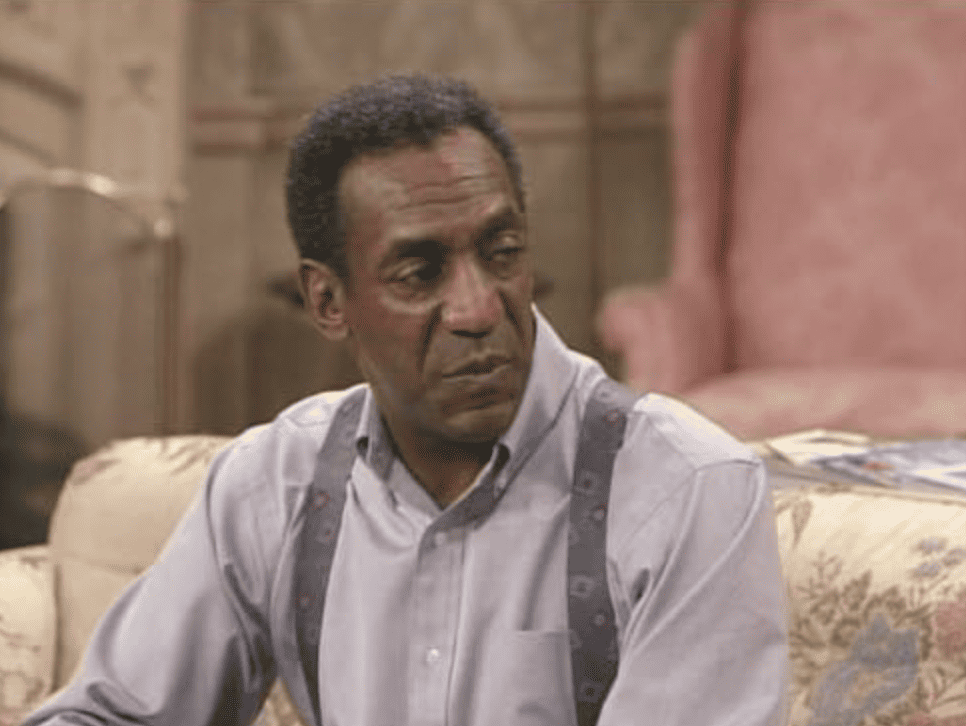
- Debut: September 20, 1984
- Number of Seasons: 8
- Where to Watch: Philo
Can you separate the art from the artist? Not when the artist’s name and reputation have been sullied to the level of Bill Cosby’s. He will be forever linked with the 60+ accusations of rape, sexual assault, and sexual harassment that have been levied against him.
This is a list of classic sitcoms American should watch but, with all of Cosby’s baggage, it is hard to argue that anyone “should” watch this show. However, it is also impossible to deny the show’s impact during its run from 1984-1992. Any discussion of groundbreaking, medium-altering sitcoms would be incomplete were “The Cosby Show” omitted.
This sitcom was the biggest TV hit of the 1980s. At a time when sitcoms were lagging, the show is credited with singlehandedly reviving the genre.
“The Cosby Show” featured a nuclear African-American family of Cliff (Cosby) and Claire Huxtable (Phylicia Rashad), and their four children: Sondra (Sabrina Le Beauf), Denise (Lisa Bonet), Theo (Malcolm-Jamal Warner), and Rudy (Keshia Knight Pulliam). The show was so beloved and the family scenarios so relatable that Cosby came to be known as “America’s Dad.”
Cliff was an OB/GYN and Claire was a successful attorney. Not since “The Jeffersons” had such an upper-middle-class black family been featured so prominently in a television series. The incredible success of the show paved the way for other sitcoms with predominantly black casts such as “Amen,” “227,” “The Fresh Prince of Bel-Air,” and “A Different World” (a spinoff of the show).
The far-reaching impact of “The Cosby Show” is undeniable. What is equally undeniable, though, is the show’s tarnished reputation due to the revelations regarding the show’s central figure.
